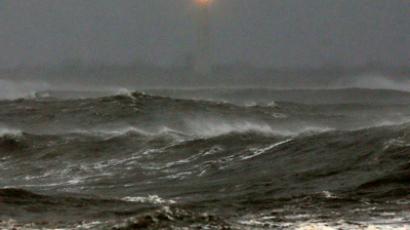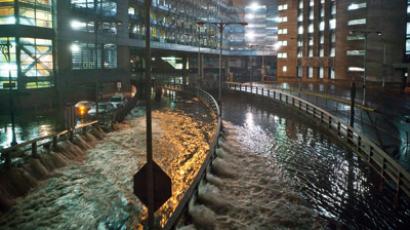‘Oyster Creek proximity to New York poses threat during flooding’ - Prof. Busby
Less than 24 hours after Hurricane Sandy ripped through eastern United States, the country’s oldest nuclear power plant – located in Forked River, New Jersey - has been has been put on alert.
You can never make nuclear power stations perfectly safe. You can’t make it impossible for these situations to occur and when they do occur, they can be pretty catastrophic, Professor Christopher Busby from the European Committee on Radiation Risks told RT. The Professor added Oyster Creek plant was a particular risk, located just 65 miles from New York City.All of the power stations in the area were built against the express wishes of the people who lived there. They were pushed through by some kind of federal axe which overcame the opposition of the people, he said. Busby spoke to RT about the possible dangers that could occur if waters from Hurricane Sandy flood the nuclear station’s cooling system. RT: What are the potential dangers as you see it?Christopher Busby: I think it’s quite unlikely that anything bad will happen. It’s not like a tsunami, it's not some big tidal wave coming at them. The problem would be that the cooling system would become flooded. The electrical systems that back up the cooling system, so there won’t be any cooling. And in these situations, with nuclear power stations, even though there might be a very remote risk of something happening, when it does happen, it’s pretty catastrophic.RT:It brings to mind Japan's Fukushima disaster last year. Are there better protection measures in place now than there were in Fukushima?CB: The problem is that with all nuclear power stations, you can never make them absolutely perfectly safe. You can make them as safe as you can get, but you can’t make it impossible for these situations to occur. And when they do occur, especially in this one, which is 65 miles south of New York City – with a very, very high population density – it would be pretty catastrophic.RT:Oyster Creek is America's oldest nuclear power plant. It was built 2 years before Fukushima. Could its age be a factor in any potential danger?CB: Of course. The older the nuclear power station, the less good the integrity of the various control systems and the actual metallic components of the control systems, too – of course if they’re older, they’re more corroded, they can be brittle as a result of neutron effects, so yes of course that’s certainly a factor. In fact, oyster creek, like all of those power stations near nyc were built against the express wishes of the people who lived there. They were pushed through by some kind of federal axe which overcame the opposition of people who lived there.RT:Officials say there are currently NO protective actions taking place outside the nuclear facility, as there is no imminent threat from radiation. Should precautions be taken anyway? CB: I think it’s more likely that there’s nothing much they can do. So there’s no point in scaring people and trying to run around and do stuff. There isn’t much they can do. All they have to do there is sit and keep their fingers crossed and hope that the flood waters don’t go so high that they actually flood the control systems and the electricity which backed it all up. That’s really the problem. So it’s not really like Fukushima in the sense of the huge amounts of energy that were unleashed then. It could be just a slow flooding affair, which could be just as nasty. RT:What’s the worst case scenario if this did happen? Would it go up like Fukushima, or does the fact that it’s already closed down mitigate any bad things that might happen there?CB: Well you could still have a meltdown, of course. The fuel inside the shutdown reactor is still extremely hot and has to be cooled, so if you don’t cool it then it gets very hot and can melt down. So yes, of course, you can still have a catastrophic problem.














